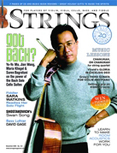
Review
More reviews

|
[Strings, No. 144, December 2006, pp. 93–94: Review by Sarah Freiberg of The Early String Quartet, vol. 4, Ignaz Pleyel, Six String Quartets, Op. 1. Reproduced by permission of Strings Magazine, © 2006 Strings Magazine.] |
Ignace Pleyel: Six Quartets, Op. 1, (Vol. 4 in the series The Early String Quartet) edited by Simon P. Keefe. Steglein Publishing, www.steglein.com, $20 (parts); $60 (score).
Thanks to recent scholarship, the string quartet repertoire boasts some welcome new music—a couple of centuries old! Steglein Publishing, which specializes in music from the 18th and 19th centuries, has published this, the latest in its series titled The Early String Quartet. Each volume has been carefully edited by a specialist in the musical styles of the time period, and consists of a set of parts and a score containing detailed biographical information and critical remarks.
Focusing on the wealth of string quartets popular in the waning years of the 18th century and the early decades of the 19th century, the series includes works originally published throughout Europe.
The four volumes produced to date include the Opus 1 Quartets of both [sic] Giovanni Battista Viotti (Vol. 1), six quartets by Luigi Boccherini (Vol. 2), and three sensational quartets by Aldabert Gyrowetz (Vol. 3). These composers may not be as familiar to us today as they were back then, though Boccherini is enjoying some renown, but these works are well worth learning, hearing, and playing.
The company's latest installation gives us the six Opus 1 Quartets from Ignace Pleyel, an exceedingly popular composer in the late 18th century, as well as a renowned publisher. Pleyel, who studied with Haydn, also traveled to Italy, Strasbourg, and London before settling in Paris in 1895 [sic]. His quartets were widely published during his lifetime, with the Opus 1 Quartets, dating from 1782–1783, much in demand.
The closing movement of the first quartet shows a Turkish influence, and the low range of the second violin, which is often playing on the G string, makes it particularly rich. The fifth quartet shows nice variety—from a humorous Allegro, which begins in unison, to a lovely slow movement featuring a written-out cadenza, followed by a rustic rondo. These three-movement works heavily favor the first violin as the melodic instrument and would be very fitting for student groups in which the first violinist is a more experienced player, perhaps even a coach.
The Steglein parts are clear and easy to read, and the accompanying scores offer informative biographical information and critical notes. While the editors attempt to be thoughtful to page turn problems, they have still left a few troublesome ones, which would require making copies and having at least three pages out at a time.
SARAH FREIBERG
Web site and database © 2001–2025 Steglein Publishing, Inc.
| Home | Editions | Books | Database | Online Texts | About | Cart |
